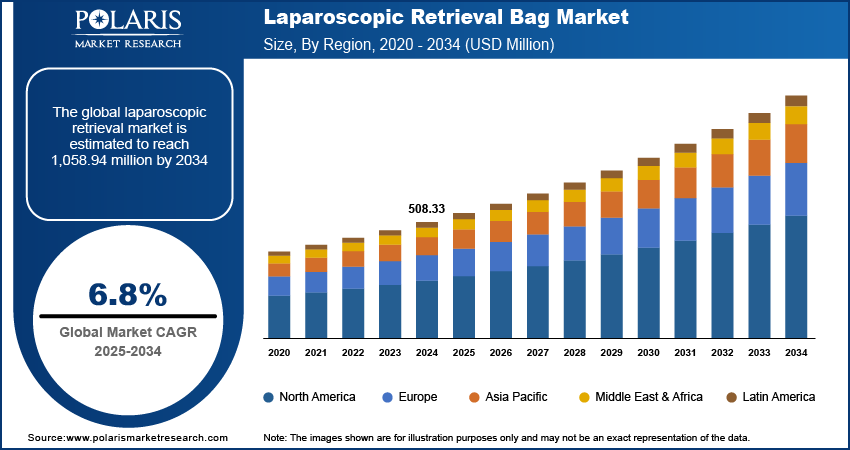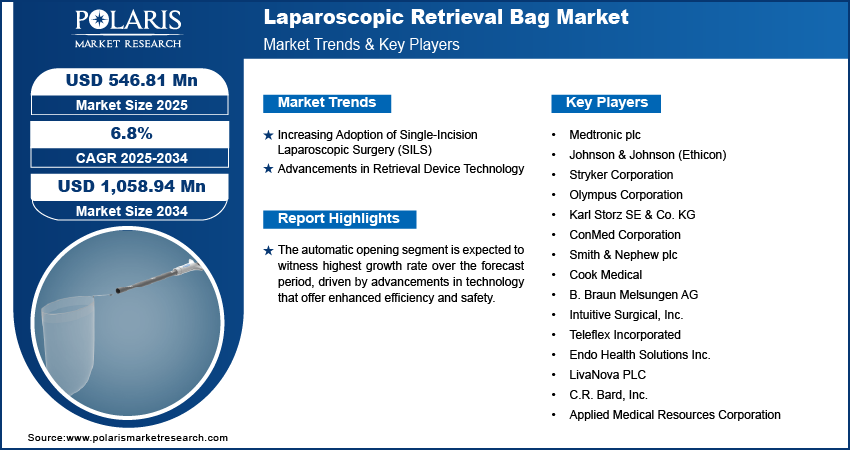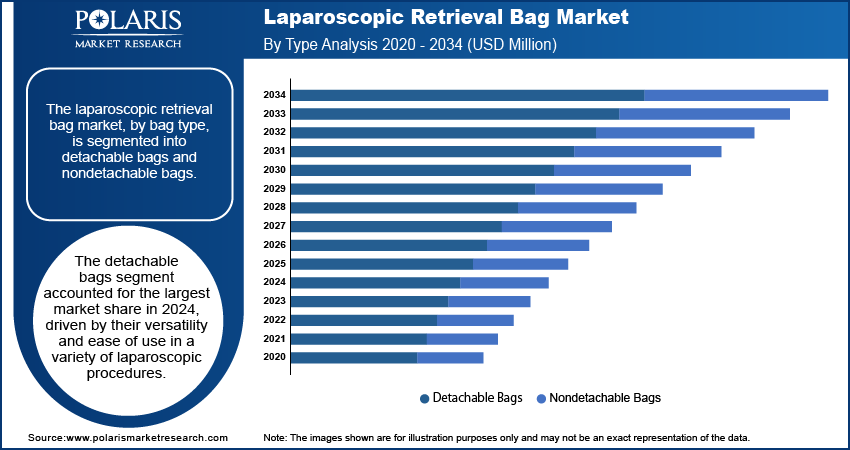
Laparoscopic Retrieval Bag Market Size, Share, Trends, & Industry Analysis Report
By Bag Type (Detachable Bags, Nondetachable Bags), By Technique, By Surgeries, By End Use, By Region – Market Forecast, 2025–2034
- Published Date:Aug-2025
- Pages: 130
- Format: PDF
- Report ID: PM5302
- Base Year: 2024
- Historical Data: 2020-2023
Market Overview
The laparoscopic retrieval bag market size was valued at USD 505.8 million in 2024 and is expected to reach USD 985.7 million by 2034, growing at a CAGR of 7.10% from 2025–2034. The market is expanding as minimally invasive surgeries become more common. Surgeons rely on these bags for secure specimen removal, helping prevent contamination. With growing demand for laparoscopic procedures in gynecology, urology, and general surgery, hospitals are steadily increasing their adoption of laparoscopic retrieval systems.
Key Insights
- The detachable bags segment led revenue in 2024, favored for its versatility and ease of use across various laparoscopic procedures.
- Manual opening bags hold a significant revenue share due to their widespread application in diverse surgical settings.
- The automatic opening segment is projected to grow at the fastest rate, driven by technological advances that enhance safety and efficiency.
- North America dominates the market in 2024, driven by advanced healthcare infrastructure, high adoption of minimally invasive surgery, and a key industry presence.
- The Asia Pacific is expected to register the fastest CAGR, driven by rising chronic disease rates and the increasing use of minimally invasive techniques.
Industry Dynamics
- Rising demand for minimally invasive surgeries and increasing prevalence of chronic diseases are boosting the adoption of laparoscopic retrieval bags, as they ensure safer specimen removal and reduce infection risks.
- Technological advancements in material quality and design enhance product efficiency, encouraging healthcare providers to prefer advanced retrieval bags.
- High costs and limited reimbursement policies restrain market growth, restricting access in developing regions.
- Expanding surgical procedures in emerging markets offer significant opportunities for market expansion and product innovation.
Market Statistics
- 2024 Market Size: USD 505.8 million
- 2034 Projected Market Size: USD 985.7 million
- CAGR (2025-2034): 7.10%
- North America: Largest market in 2024

To Understand More About this Research: Request a Free Sample Report
The market involves the development, production, and sale of devices used in minimally invasive surgeries to retrieve tissues, organs, and foreign objects. This market is driven by the increasing adoption of minimally invasive surgical techniques due to their advantages, such as reduced recovery time and lower risk of complications. Key future trends include the growing preference for single-incision laparoscopic surgery (SILS) and the rising demand for advanced retrieval devices with enhanced precision and safety. Additionally, technological advancements are primarily aimed at enhancing bag durability, safety, and usability in minimally invasive surgeries. The increasing prevalence of chronic diseases requiring surgical intervention is further driving the industry growth.
Market Drivers and Trends
Increasing Adoption of Single-Incision Laparoscopic Surgery (SILS)
Single-incision laparoscopic surgery (SILS) is gaining traction as a preferred method in the laparoscopic retrieval market. SILS involves a single entry point, typically through the navel, resulting in fewer scars and potentially faster recovery times compared to traditional multi-port laparoscopic surgery. According to a study published in the Journal of Minimal Access Surgery, SILS has shown a significant reduction in postoperative pain and better cosmetic outcomes, which has led to its increasing adoption across hospitals and surgical centers. The growing demand for less invasive procedures is pushing manufacturers to develop specialized retrieval devices compatible with SILS, which would drive the laparoscopic retrieval bag market growth.
Advancements in Retrieval Device Technology
Technological advancements are playing a crucial role in shaping the laparoscopic retrieval market. Manufacturers are focusing on developing more efficient and safer retrieval devices, such as those with improved grasping and cutting capabilities, to enhance the precision and safety of laparoscopic procedures. A report by Surgical Endoscopy highlights the introduction of devices equipped with articulating tips and enhanced imaging capabilities, which allow for better navigation and tissue manipulation during surgery. These innovations are improving surgical outcomes and expanding the application of laparoscopic retrieval techniques to more complex procedures. All these factors boost the industry growth .
Rising Prevalence of Chronic Diseases Requiring Surgical Intervention
The increasing prevalence of chronic diseases, such as colorectal cancer and gallstones, propels the demand for laparoscopic retrieval procedures. The growing aging population is more prone to chronic diseases and surgical interventions. The World Health Organization (WHO) reported that colorectal cancer is the third most common cancer worldwide, with approximate 1.93 million new cases in 2020. As minimally invasive surgeries become the standard of care for treating these conditions, the demand for advanced laparoscopic retrieval devices rises, which contributes to the market growth.

Segmental Insights
Bag Type Outlook
The detachable bags segment accounted for the largest revenue share in 2024, driven by their versatility and ease of use in a variety of laparoscopic procedures. Detachable bags offer the advantage of being removed independently from the laparoscopic instrument, allowing for safe and efficient retrieval of larger or multiple tissue samples. Their popularity is propelled by the increasing demand for single-incision laparoscopic surgeries, where detachable bags are preferred due to their compatibility with smaller incisions.
The nondetachable bags segment is registering a higher growth rate in the market due to their cost-effectiveness and simplicity, making them a popular choice in emerging markets and among healthcare facilities with budget constraints. These bags are typically integrated with the laparoscopic instrument, reducing the need for additional tools and making them easier to manage during surgery. The rising number of minimally invasive procedures globally, coupled with advancements in nondetachable bag designs that enhance their reliability and safety, is driving the growth of this segment.
Technique Outlook
The manual opening segment holds a larger revenue share, largely due to its widespread use in a variety of surgical settings. Surgeons often prefer manual opening devices for their simplicity, reliability, and lower cost, making them a standard choice in routine and complex laparoscopic procedures. The ease of use and the ability to control the opening mechanism manually contribute to the popularity of these devices, particularly in settings where precision and surgeon control are paramount.
The automatic opening segment is expected to witness highest growth rate over the forecast period, driven by advancements in technology that offer enhanced efficiency and safety. Automatic opening devices provide a consistent and quicker deployment of the retrieval bag, reducing the time spent on critical procedures and potentially lowering the risk of complications. These devices are gaining traction in high-volume surgical centers and advanced healthcare facilities, where efficiency and reduced operating time are critical factors. Thus, The rising need for innovative, time-efficient surgical tools will continue to propel the rapid growth of the automatic opening segment in the coming years.

Regional Analysis
North America laparoscopic retrieval bag market holds the largest share in 2024, due to the region's advanced healthcare infrastructure, high adoption rate of minimally invasive surgeries, and the presence of key industry players. The US, in particular, drives this dominance with its significant investments in healthcare technologies and the increasing prevalence of chronic conditions that require surgical intervention. Additionally, the growing awareness of the benefits of laparoscopic procedures, coupled with favorable reimbursement policies, supports the market expansion in North America. Other regions such as Europe and Asia Pacific is also witnessing growth, driven by technological advancements and increasing healthcare expenditure.
The Asia Pacific laparoscopic retrieval bag market is expected to witness fastest CAGR over the forecast period due to the increasing prevalence of chronic diseases and the rising adoption of minimally invasive surgical techniques. Countries such as China and India are significant contributors to this growth, driven by their large population bases and improving healthcare infrastructure. The industry is also supported by a growing middle-class population with increasing healthcare spending and advancements in medical technology. Furthermore, the expansion of healthcare facilities and rising awareness of minimally invasive procedures among healthcare professionals and patients are a few key factors driving the growth in Asia Pacific.

Key Players and Competitive Insights
Key players in the industry include Medtronic plc; Johnson & Johnson (Ethicon); Stryker Corporation; Olympus Corporation; Karl Storz SE & Co. KG; ConMed Corporation; Smith & Nephew plc; Cook Medical; B. Braun Melsungen AG; Intuitive Surgical, Inc.; Teleflex Incorporated; Endo Health Solutions Inc.; LivaNova PLC; C.R. Bard, Inc.; and Applied Medical Resources Corporation. All these companies are actively engaged in the market, offering a range of laparoscopic retrieval solutions and continually advancing their technologies to meet the evolving demands of minimally invasive surgery.
In the competitive landscape, Medtronic plc and Johnson & Johnson (Ethicon) stand out for their extensive product portfolios and significant investments in research and development. Medtronic's robust range of laparoscopic retrieval bags and its focus on integrating advanced technology into its products support its strong market position. Johnson & Johnson’s Ethicon division is known for its innovative solutions and comprehensive offerings, positioning it well within the market. Both companies leverage their extensive distribution networks and global presence to maintain their market position.
Stryker Corporation is a medical technology company that specializes in providing a wide range of healthcare solutions. The company manufactures orthopedic implants, surgical equipment, surgical navigation systems, neurotechnology, and spine products and also provides associated services. Their extensive product line includes patient handling equipment, intensive care disposable products, emergency medical equipment, communication devices, and endoscopic systems. In addition to this, Stryker offers neurovascular and spinal devices, neurosurgical equipment, and medical equipment for various medical conditions.
Medtronic plc is a developer, manufacturer, and seller of device-based medical therapies. The company's business operations are divided into Cardiovascular Portfolio, Medical Surgical Portfolio, Neuroscience Portfolio, and Diabetes Operating Unit. Medtronic's cardiovascular portfolio segment specializes in implantable cardiac devices such as defibrillators, pacemakers, and resynchronization therapy devices. Additionally, it offers insertable cardiac monitor systems, cardiac ablation products, TYRX products, and remote patient-centered and monitoring software.
Key Companies
- Medtronic plc
- Johnson & Johnson (Ethicon)
- Stryker Corporation
- Olympus Corporation
- Karl Storz SE & Co. KG
- ConMed Corporation
- Smith & Nephew plc
- Cook Medical
- B. Braun Melsungen AG
- Intuitive Surgical, Inc.
- Teleflex Incorporated
- Endo Health Solutions Inc.
- LivaNova PLC
- C.R. Bard, Inc.
- Applied Medical Resources Corporation
Industry Developments
- In July 2024, Vernacare Ltd (backed by H.I.G. Capital) relocated USD 4.54 million worth of its surgical tool production, including laparoscopic retrieval bags, from China to its UK facilities in Worksop, Newtown (Wales), and England. This strategic shift enhances its manufacturing capacity, strengthens supply chain resilience, and supports future market demand
- In February 2024, chemical producer DuPont announced that its DuPont AmberLite EV2X resin, an effective glycol-purification solution, could prolong the lifespan of EV coolant while reducing glycol maintenance needs. The resin achieves this by offering improved thermal stability and superior operating characteristics in comparison to conventional ion exchange resins available on the market.
- In August 2023, E-valucon and Boyd collaborated to develop liquid-to-air cooling system specifically designed for DC Fast Charging cables and connectors, enabling faster and safer charging.
- In September 2023, Ethicon (Johnson & Johnson) launched a new generation of laparoscopic retrieval bags that incorporate advanced materials to improve durability and ease of use during surgeries.
- In July 2023, Medtronic launched its new suite of minimally invasive surgical tools designed to enhance precision and safety during laparoscopic procedures, reflecting its commitment to advancing surgical technologies.
Laparoscopic Retrieval Bag Market Segmentation:
By Bag Type Outlook (Revenue, USD Million; 2020–2034)
- Detachable Bags
- Endo Bag
- MemoBag
- Others
- Nondetachable Bags
- ReliaCatch
- Endo Catch
- ENDOPOUCH RETRIEVER Specimen Bag
- Anchor line
- Inzii
- Others
By Technique Outlook (Revenue, USD Million; 2020–2034)
- Manual Opening
- Automatic Opening
By Surgeries Outlook (Revenue, USD Million; 2020–2034)
- Bariatric Surgery
- Urological Surgery
- Gynecological Surgery
- General Surgery
- Colorectal Surgery
- Other Surgeries
By End Use Outlook (Revenue, USD Million; 2020–2034)
- Hospitals
- Clinics
- Ambulatory Surgical Centers
By Regional Outlook (Revenue, USD Million; 2020–2034)
- North America
- US
- Canada
- Europe
- Germany
- France
- UK
- Italy
- Spain
- Netherlands
- Russia
- Rest of Europe
- Asia Pacific
- China
- Japan
- India
- Malaysia
- South Korea
- Indonesia
- Australia
- Vietnam
- Rest of Asia Pacific
- Middle East & Africa
- Saudi Arabia
- UAE
- Israel
- South Africa
- Rest of Middle East & Africa
- Latin America
- Mexico
- Brazil
- Argentina
- Rest of Latin America
Laparoscopic Retrieval Bag Market Report Scope
|
Report Attributes |
Details |
|
Market Size in 2024 |
USD 505.8 million |
|
Market Size in 2025 |
USD 541.3 million |
|
Revenue Forecast by 2034 |
USD 985.7 million |
|
CAGR |
7.10% from 2025 to 2034 |
|
Base Year |
2024 |
|
Historical Data |
2020–2034 |
|
Forecast Period |
2025–2034 |
|
Quantitative Units |
Revenue in USD million and CAGR from 2025 to 2034 |
|
Report Coverage |
Revenue Forecast, Market Competitive Landscape, Growth Factors, and Trends |
|
Segments Covered |
|
|
Regional Scope |
|
|
Competitive landscape |
|
|
Report Format |
|
|
Customization |
Report customization as per your requirements with respect to countries, regions, and segmentation. |
FAQ's
The global laparoscopic retrieval bag market size was valued at USD 505.8 million in 2024 and is projected to grow to USD 985.7 million by 2034.
The global market is projected to register a CAGR of 7.10% during the forecast period.
In 2024, North America accounted for the largest share of the global market due to the region's advanced healthcare infrastructure.
A few key players in the laparoscopic retrieval bag market include Medtronic plc; Johnson & Johnson (Ethicon); Stryker Corporation; Olympus Corporation; Karl Storz SE & Co. KG; ConMed Corporation; Smith & Nephew plc; Cook Medical; B. Braun Melsungen AG; Intuitive Surgical, Inc.; Teleflex Incorporated; Endo Health Solutions Inc.; LivaNova PLC; C.R. Bard, Inc.; and Applied Medical Resources Corporation.
The detachable bag segment accounted for a larger share of the global market due to versatility and ease of use in a variety of laparoscopic procedures.
The manual opening technique segment accounted for a larger share of the global market due to its widespread use in a variety of surgical settings.
A laparoscopic retrieval bag is a medical device used in minimally invasive surgeries to collect and remove tissue, organs, and foreign objects from the patient's body. During laparoscopic procedures, the bag is inserted through a small incision and can be used to gather and contain the items to be retrieved. Once the retrieval bag is filled, it is withdrawn through the same incision or another access point.
A few key trends in the laparoscopic retrieval bag market are described below: Rising Adoption of Single-Incision Laparoscopic Surgery (SILS): Increasing preference for SILS due to its benefits, including fewer scars and faster recovery, is driving demand for compatible retrieval bags. Technological Advancements: Development of advanced retrieval bags with features such as enhanced precision, safety, and compatibility with newer surgical technologies. Growing Demand for Minimally Invasive Procedures: Rising patient and provider preference for minimally invasive surgeries due to their benefits, including reduced recovery time and lower complication rates. Focus on Product Innovation: Continuous improvements in bag materials and designs to enhance performance and ease of use, including the introduction of automatic opening mechanisms.
A new company entering the laparoscopic retrieval bag market must focus on developing innovative products that incorporate advanced materials and technologies, such as automatic opening mechanisms and enhanced durability features. Emphasizing research and development to create unique solutions that address current limitations or gaps in the market can provide a competitive edge. Additionally, targeting emerging markets with growing healthcare needs and investing in strategic partnerships with hospitals and surgical centers can help establish a strong market presence.
Companies producing laparoscopic retrieval bags and related products, healthcare providers, and other consulting firms must buy the report.
